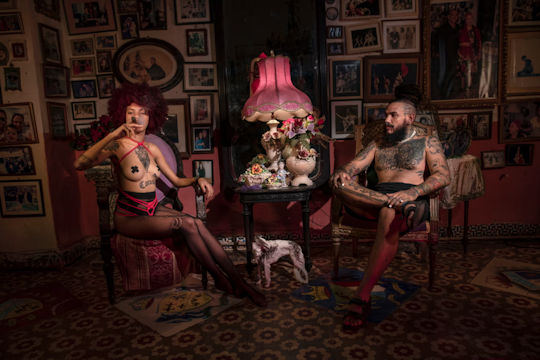Source: Theguardian.com
CUBA – ‘Felix runs a weekly class teaching the art of Japanese bondage in Havana. It was his idea to have Katy smoking a cigar. They’re part of a subculture most foreigners don’t know exists’

Ibecame interested in Cuba 30 years ago and made numerous visits over the years, some of them photography related. I never showed any of that early work: the country has been photographed so much it was hard to find a new voice. But a few years ago, I started seeing things I’d not seen before – subcultures that most foreigners don’t even know exist.
The perception of Cuba – mostly because of the communist regime – is that it’s very normative. I remember being told that it was illegal in some Soviet countries to listen to rock’n’roll or wear jeans. Foreigners think that in Cuba there’s no personal expression and that everything is bland and uniform. And it’s not true.

There’s a full rainbow of LGBTQ+ communities there, along with tattoo and piercing enthusiasts, punks, rappers, rockabilly, bodybuilding. My goal with the New Cubans project was to go a little deeper into the Havana underground
“Tattoo parlours were once illegal in Cuba but today they seem to be tolerated. In Havana, tattoos have exploded”
The first thing I acknowledged is that young people in Cuba are no longer isolated. The internet only became ubiquitous five years ago – before that it was very complicated and inefficient to get online. But they’re now connected to the rest of the world and their influences are global. All the young people I shot for my book would ask me: “When can we get the photos to put on Instagram?”
Like any young generation, Cubans have also become more progressive, more liberated. This is something that surprises foreigners as well, that Cuba is actually quite permissive and has been one of the leading countries in Latin America in terms of LGBTQ+ rights.
This photograph was taken in 2021 and is the first in the series. My collaborator, Devon Ruiz, took me to the home of the guy who used to run the Cuban National Ballet. The house itself seemed fixed in time from 60 years ago, but when I walked in, there was a bunch of young people who could have been plucked out of Berlin, Tokyo or LA. The contrast was so interesting that I decided to go back to photograph Katy and Felix.
Felix runs a weekly group to teach shibari – the art of Japanese bondage. It’s like an edgy arts and crafts session. He introduced me to Katy, who was a participant. She had studied chemistry at university but dropped out, getting interested in art, doing a bit of modelling. She seemed tough, self-affirming and full of attitude, so I wanted the photograph to suggest that. A lot of the people in my photos are amplifying their identity.
Tattoo parlours were once illegal in Cuba but today they seem to be tolerated and in Havana tattoos have exploded in the past five years. Why is Katy topless? That was their suggestion.
“Almost a third of young people I shot have left the country
There’s no explicit sexual nature to shibari, but there’s always some nudity involved . Felix suggested the cigar – the only one in the whole project. To me, it felt like a bit of a provocation. This photograph is really about the contrast between the traditional values of Cuba and this generation that embraces a progressive outlook.
The New Cubans is a cultural, not a political project. But it’s important to acknowledge how hard life is in Cuba right now. The economic collapse of the past few years has had dire consequences. The response, for many, is to leave the country. The Cuban government recently estimated that 10% of the population has left in the past two years alone.
Of course, a lot of those are younger folks. Almost a third of those that I shot have left the country since I took the photographs. So the whole project, at some point, almost became an attempt to capture images of social circles that are rapidly disintegrating. Katy actually told me just last week that she’s moved to Montreal. So this is a memento of her life in Cuba.
Jean-François Bouchard’s CV
Born: Montreal, 1968
Trained: “Lawyer gone rogue/self-taught.”
Influences: “I’ve been influenced by photographers at the complete ends of the photographic spectrum. Conceptual artists who are part of the ‘Vancouver School’ of photography (Jeff Wall, Rodney Graham, Stan Douglas) and their imaginary worlds at one end, at the other, photojournalists and documentarians rooted in reality (Lauren Greenfield, Diane Arbus, James Nachtwey). The Cuban photographer Alejandro González was also a significant inspiration.”
High point: “Having a career. It is so hard to make photography more than a pastime that I still can’t quite believe I am now regarded as a professional. I suffer from acute impostor syndrome.”
Low point: “Spending tons of money and time shooting a project that turned out to look great, but on a flawed and disrespectful premise. I had to scrap the whole thing.”
Top tip: “Kill your babies. As image makers, it is easy to fall in love with your photographs. But you must love your career more and that means killing most of the work. Unless your name is Wolfgang Tillmans, don’t show dozens upon dozens of images in an exhibition.”
Jean-François Bouchard’s photobook The New Cubans is published on 19 November. Order here (UK) or here (rest of world) and follow @jfbouchard1 for more of his work.

